Time:2021-11-24Views:
When designing a PCB, we usually rely on previous experience and tips that we would normally find online. Every PCB design can be optimized for a specific application. Typically, its design rules apply only to the target application. For example, analog-to-digital converter PCB rules do not apply to RF PCBs. The opposite description is also inappropriate.
However, certain guidelines can be considered general to any PCB design. Here, I'll cover some basic questions and tips that can dramatically improve your PCB design.
Power and Signal Distribution
Power distribution is a critical element in any electrical design. All your components rely on power to perform their functions. Depending on your design, some components may have the best power connections and some components on the same board may have the worst power connections.
For example, if all components are powered by one trace, each component will observe a different impedance, resulting in multiple ground references. For example, if you have two ADC circuits, one at the beginning and one at the end, and both ADCs read an external voltage, each analog circuit will read a different power relative to themselves.
We can summarize the power distribution in 3 possible ways: single point source, star source and multipoint source.
A. single point source
The power and ground wires for each component are separated from each other. The power traces of all components meet only at a single reference point. A single point is considered best for power. However, for complex or large/medium sized projects this is not feasible.
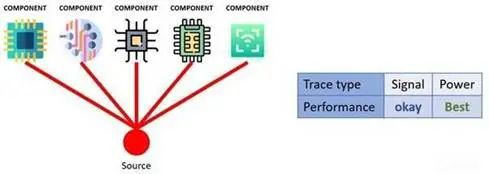
B. star source
The star source can be seen as an improvement of the single point source. It differs due to its key feature: the same length of traces between components. Star connections are often used for complex high-speed signal boards with various clocks. In a high-speed signal PCB, the signal usually comes from the edges and then to the center. All signals can travel from the center to any area of the board with minimal delay between areas.
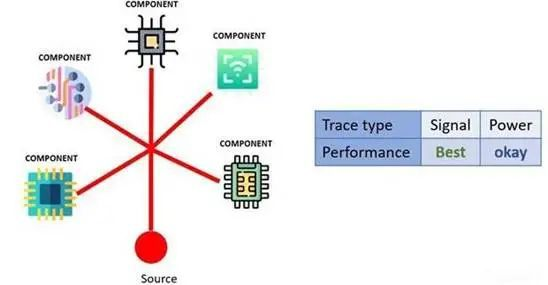
C. multipoint source
considered the worst in any case. However, it is easiest to use in any circuit. Multiple point sources can create reference differences between components and in common impedance coupling. This design style also allows high switching ICs, clocks and RF circuits to introduce noise in nearby circuits that share connections.
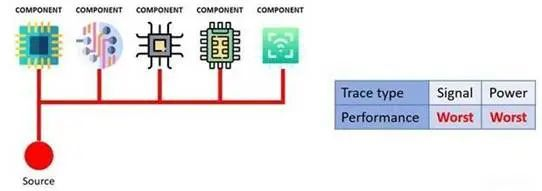
Of course, in our daily life, we will not always be able to have a single type of distribution. The best compromise we can achieve is to mix single and multi-point sources. You can have analog sensitive equipment and high speed/RF systems in one spot, while all other less sensitive peripherals in one spot.
Powered Aircraft
Have you ever wondered if you should use a power plane? The answer is yes. Power flat panel is one of the best ways to deliver power and reduce noise in any circuit. It shortens the ground path, reduces inductance, and improves electromagnetic compatibility (EMC) performance. Thanks to that, the power planes on both sides also create a parallel plate decoupling capacitor,which preventing noise propagation.
The power flat panel also has a distinct advantage: Due to the larger area, it allows more current to pass through, thereby increasing the operating temperature range of the PCB.
But please note: Power planes can improve operating temperature, but routing must also be considered. The trace rules are given by IPC-2221 and IPC-9592 For PCBs with RF sources (or any high speed signal application) you must have a complete ground plane to improve the performance of the board. The signals must be on different planes, and it is nearly impossible to meet both requirements with a two-layer board. If you want to design an antenna or any low complexity RF board, you can do it with two layers. The image below shows an illustration of how your PCB can make better use of these planes.

In mixed-signal designs, pcb manufacturers often recommend separating analog ground from digital ground. Sensitive analog circuits are susceptible to high-speed switching and signals. If the analog and digital grounds are different, the ground planes will be separated.
However, there are the following disadvantages. We should pay attention to the crosstalk and loop areas that split the ground mainly due to discontinuities in the ground plane. The figure below shows an example of two separate ground planes. On the left, the return current cannot pass directly along the signal traces, so there is a loop area that is not designed on the right.

Electromagnetic Compatibility and Electromagnetic Interference (EMI)
For high frequency designs such as RF systems, EMI can be a big disadvantage. It was mentioned earlier that ground planes help mitigate EMI, but depending on your PCB, ground planes may present other problems. In laminates with four or more layers, the distance to the plane is critical. When the inter-plane capacitance is small, the electric field will spread across the board. At the same time, the impedance between the two planes is reduced, allowing return current to flow to the signal plane. This will create EMI for any high frequency signals that pass through the plane.

Simple solutions to avoid generating EMI are: Prevent high-speed signals from traversing multiple layers.Add decoupling capacitors,to place ground vias around signal traces. The image below shows a good PCB design with high frequency signals.
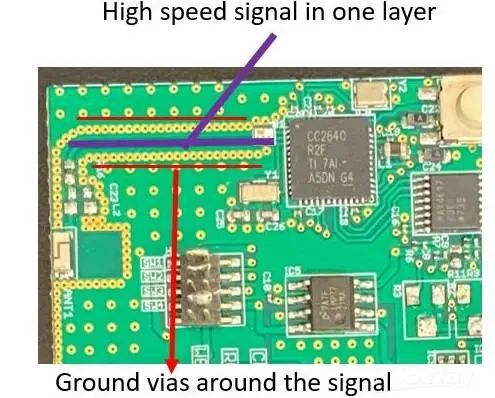
Filter Noise
Bypass capacitors and ferrite beads are capacitors used to filter noise generated by any component. Basically, any I/O pin can be a source of noise if they are used in any high speed application. In order to make better use of them, we will have to pay attention to the following:
l Always place ferrite beads and bypass capacitors as close as possible to noise sources.
l When we use auto-placement and auto-routing, distance should be considered for checking.
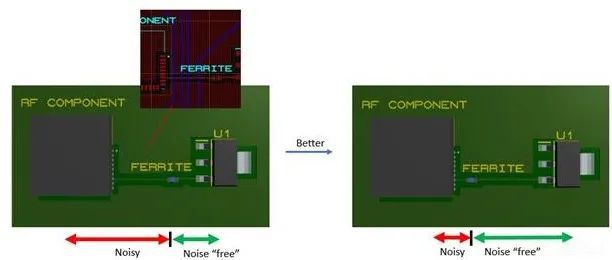
l Avoid vias and any other traces between the filter and the component.
l If there is a ground plane, use multiple vias to properly ground it.
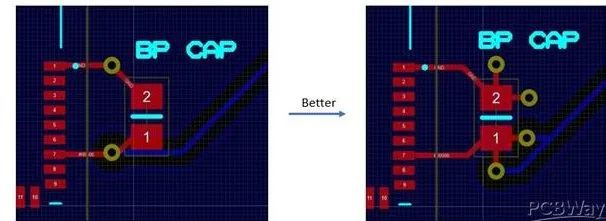
A Helping Hand
As you can see, there are many considerations to make when it comes to PCB design. If you’re struggling to get it right, we can help. At XCF FPCB manufacturer, we have 8 years experience working with clients ranging from individuals to Fortune 500 companies and helping them bring their PCB designs to life. From our groundbreaking design software to our production capabilities, we have a solution no matter what your needs might be. Contact us today to schedule your consultation or to learn more about our capabilities and services.

